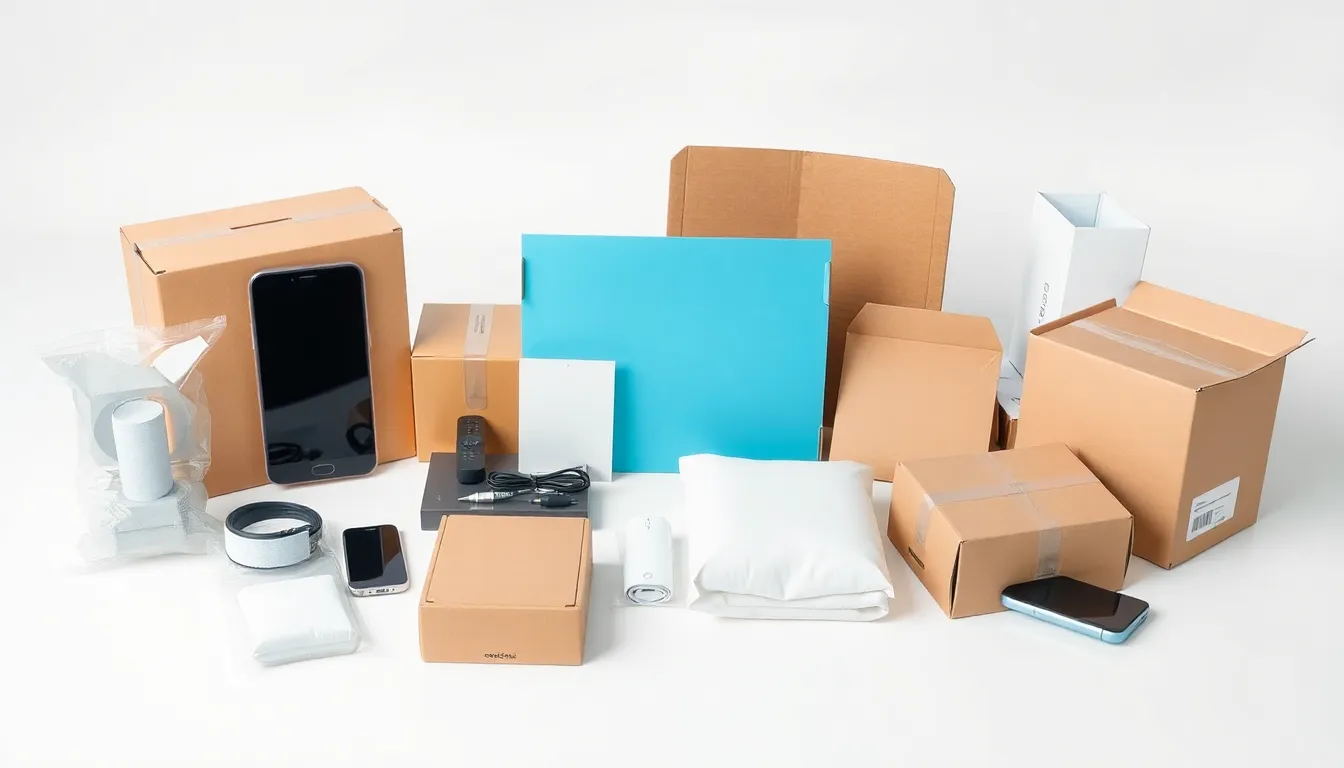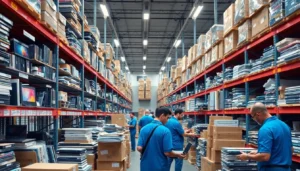In the fast-paced world of consumer electronics, packaging often plays the unsung hero. It’s not just a pretty box; it’s the first impression that can make or break a sale. Imagine unboxing a shiny new gadget only to be greeted by a flimsy, uninspiring package. Talk about a buzzkill! Smart packaging not only protects devices but also enhances the user experience, making it feel like you’re unwrapping a treasure rather than just another gadget.
With the rise of eco-conscious consumers, the stakes are even higher. Brands that nail their packaging can win hearts and wallets. So whether it’s sleek designs or sustainable materials, the right packaging can elevate a product from ordinary to extraordinary. Dive into the world of consumer electronics packaging, where creativity meets functionality, and discover how it shapes the future of technology one box at a time.
Table of Contents
ToggleOverview of Consumer Electronics Packaging
Consumer electronics packaging plays a vital role in presenting products to buyers. Effective packaging not only safeguards the product but enhances the overall consumer experience.
Importance in the Market
Packaging significantly impacts market perception and sales. It serves as a critical marketing tool, influencing consumer decisions at the point of purchase. Customers often associate packaging quality with product quality, which can drive their purchasing behavior. Compelling designs attract attention on store shelves and online platforms, increasing visibility. Brands that prioritize innovative packaging solutions can differentiate themselves in a competitive landscape. Moreover, eco-friendly materials appeal to sustainability-conscious consumers, growing market share among environmentally aware demographics.
Key Elements of Effective Packaging
Several elements contribute to effective packaging design. Clarity in information ensures consumers understand product features and benefits at a glance. User-friendly designs enhance the unboxing experience, fostering customer loyalty. Durable materials provide protection against damage during shipping and handling while maintaining aesthetic appeal. Visual elements like color and typography should align with brand identity to create a cohesive image. Incorporating sustainability reduces environmental impact and resonates with eco-minded consumers. Overall, strategic packaging design balances functionality with creativity, playing a crucial role in consumer satisfaction.
Types of Packaging Materials

Packaging materials in consumer electronics play a vital role in both protection and marketing appeal. Various materials cater to different needs and consumer preferences.
Plastic and Its Varieties
Plastic offers versatility in packaging. Common types include polyethylene, polypropylene, and polystyrene. Polyethylene provides a barrier against moisture, while polypropylene is often used for its clarity and durability. Polystyrene serves as an excellent insulator for fragile items. Companies frequently utilize recycled plastics, which appeals to eco-conscious consumers. Brands benefit from plastic’s lightweight nature, reducing shipping costs and environmental impact.
Paper and Cardboard Options
Paper and cardboard serve as popular choices for packaging. Cardboard boxes provide strength and protection, making them suitable for shipping electronic devices. Kraft paper is appreciated for its rustic look and ease of customization. Printed paperboard can enhance brand visibility on shelves. The lightweight nature of these materials also lowers shipping expenses. Innovations in paper coatings can enhance resistance to moisture, improving product safety.
Sustainable Packaging Solutions
Sustainable packaging solutions gain traction as customers prioritize environmental responsibility. Options like biodegradable plastics and compostable materials offer greener alternatives. Recyclable cardboard and paper products align with consumer expectations for eco-friendly practices. Brands embracing these materials often enhance their reputation and customer loyalty. Additionally, minimalistic packaging designs reduce material usage, further lowering environmental impact. Promoting sustainability in packaging can significantly influence purchasing decisions.
Design Considerations for Consumer Electronics Packaging
Thoughtful design plays a crucial role in consumer electronics packaging. The balance between aesthetics and functionality significantly impacts consumer perception and satisfaction.
Branding and Aesthetics
Visual elements define a brand’s identity. Unique colors and logos create instant recognition on shelves and online platforms. Attractive packaging captures attention and communicates the brand’s values and quality. Typography choices convey messages effectively, influencing consumer emotions. Consistency in design across product lines reinforces brand loyalty. Consumers often perceive well-designed packaging as a reflection of product excellence. Eye-catching designs draw consumers in while enhancing their overall purchase experience. Skilful integration of creativity and branding elements leads to memorable first impressions.
Functionality and Protection
Effective packaging ensures product safety during transit and display. Durable materials withstand environmental factors, preventing damage before purchase. User-friendly designs facilitate easy access without compromising integrity. Structural elements should support the device while providing a seamless unboxing experience. Innovative designs enhance function, offering storage solutions or additional information. Customers appreciate labels indicating usage instructions or installation guides. Moreover, packaging that minimizes waste contributes to sustainability efforts, appealing to eco-conscious buyers. Prioritizing both protection and functionality leads to greater consumer satisfaction and product retention rates.
Trends in Consumer Electronics Packaging
Rapid changes influence consumer electronics packaging. These trends reflect a deeper understanding of consumer needs and environmental considerations.
Eco-Friendly Initiatives
Sustainable practices increasingly shape packaging strategies. Brands opt for biodegradable materials that minimize environmental impact. Recycled plastics gain popularity for their dual purpose of reducing waste and attracting eco-conscious consumers. Innovations in paper and cardboard enhance moisture resistance, ensuring protection while maintaining sustainability. Minimalistic designs further support eco-friendly initiatives by using less material and lowering carbon footprints. Companies leveraging these eco-friendly options appeal to a growing demographic concerned with environmental responsibility. Packaging choices now serve as a statement of brand values, appealing to conscious consumers.
Smart Packaging Innovations
Technology integrates with design to elevate packaging functionality. Smart packaging solutions utilize QR codes and NFC technology for enhanced consumer interactions. These features enable users to access product information, instructions, or promotional content through their smartphones. Interactive packaging also fosters a memorable unboxing experience, increasing customer engagement. Enhanced durability improves protection during transit while ensuring appealing displays. Brands embracing these innovations emphasize modernity and connectivity, aligning with consumer expectations for tech-enhanced products. Smart solutions reshape perceptions of packaging, transforming it into an extension of the product itself.
Effective consumer electronics packaging is more than just a protective layer. It’s a vital tool that shapes consumer perceptions and drives purchasing decisions. As brands navigate the competitive landscape, the integration of sustainability and innovative design will be key in winning over eco-conscious consumers.
The balance between aesthetics and functionality remains crucial in creating memorable unboxing experiences. By prioritizing durable materials and user-friendly designs, companies can enhance customer satisfaction while reinforcing brand identity.
As technology evolves, packaging will continue to play a significant role in marketing strategies. Brands that embrace these changes will not only thrive but also contribute positively to environmental sustainability.



